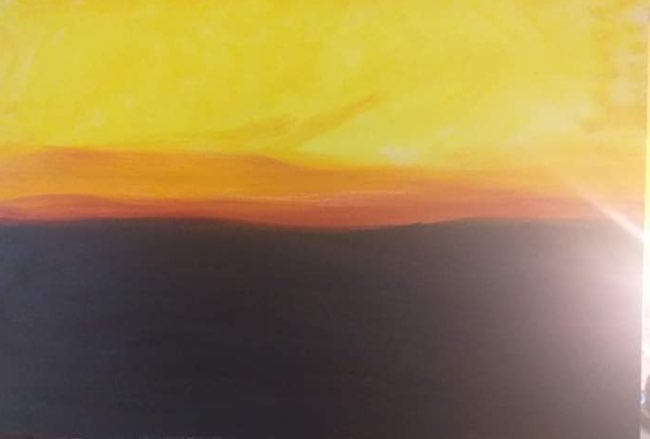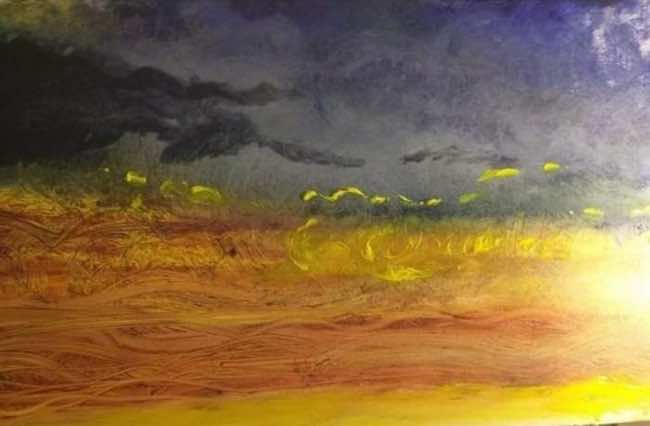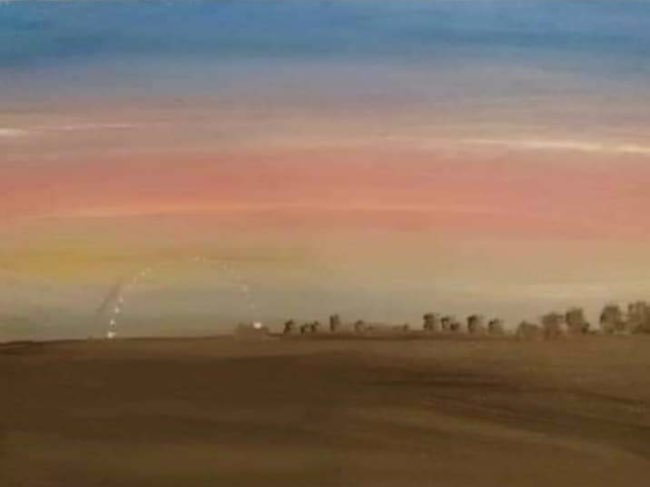La contemplazione della natura sembra essersi allontanata nel vivere contemporaneo dove spesso l’essere umano è sopraffatto dagli impegni quotidiani, delle cose da fare, dagli obiettivi da conseguire; eppure, malgrado la disattenzione dell’uomo, esistono fenomeni semplici e immediati che si susseguono e che offrono spunti di costante meditazione, di confronto tra la grandezza del mondo in cui viviamo e l’irrisorietà dell’individuo che di fatto è costantemente in balìa della natura stessa. Questo tipo di osservazione non sfugge a quegli artisti che sentono il bisogno di mantenere quel contatto costante, come se dal legame con quelle energie spontanee e naturali potesse scaturire un ascolto più profondo del senso dell’esistenza, del ruolo dell’uomo e della sua capacità di attingere proprio dagli eventi della natura per apprendere la vera essenza e al tempo stesso il carattere transitorio dell’uomo nel mondo. La protagonista di oggi sceglie uno stile del passato per narrare le sue emozioni più profonde nel momento in cui entra in contatto con l’elemento naturale, quello che può essere visto e percepito ogni qual volta il suo sguardo viene catturato da un tramonto, da un mare in tempesta, insomma da una manifestazione delle forze che ruotano accanto all’essere umano.
Tra la fine del Settecento e l’inizio dell’Ottocento nacque in Germania un movimento artistico che si proponeva di recuperare il rapporto tra uomo e spiritualità, tra il divino che si manifestava nella natura e la consapevolezza dell’individuo di essere solo una minima espressione fuggevole della forza e dell’immensità di tutto il mondo che in realtà lo ospita, lo domina, gli sopravvive. Il Romanticismo, questo il nome della corrente pittorica, ebbe caratteristiche differenti sulla base del paese di provenienza degli artisti che ne fecero parte, e si orientò verso la contemplazione paesaggistica in Inghilterra che ebbe tre tra i maggiori rappresentanti di questo stile pittorico, William Blake, William Turner e John Constable i quali si concentrarono su aspetti differenti dell’osservazione della natura. Mentre William Blake esplorò il mondo dei sogni e delle visioni, affermandosi come rappresentante della corrente onirica, John Constable si concentrò invece sulla riproduzione realistica delle vedute dei paesaggi inglesi appartenenti al suo mondo, al suo scrigno emotivo, dando così vita alla corrente pittoresca. Ma quello che tra tutti si lega indissolubilmente al Romanticismo e che ha saputo lasciare un profondo segno nella pittura di ogni tempo, che fu in grado di ispirare persino le linee guida del successivo Impressionismo, fu William Turner il quale descrisse e narrò il rapporto tra uomo e natura, l’esiguità dell’individuo davanti alla grandezza del sublime che dagli eventi come i maremoti, le burrasche, le tempeste, gli incendi, scaturiva lasciando l’osservatore senza parole, completamente affascinato e travolto dalla capacità del pittore di rappresentare le sfaccettature della luce, la forza travolgente di quegli eventi atmosferici che inducevano, e tutt’oggi inducono, a riflettere sull’inconsistenza e la transitorietà della figura umana.

L’artista milanese Alda Delledonne si collega al Romanticismo di William Turner, in particolar modo per la sua capacità di descrivere la maestosità delle circostante naturali che si dispiegano davanti ai suoi occhi, così come per l’approccio alla luce che in qualche modo diviene protagonista delle sue tele tanto quanto i mari burrascosi e i paesaggi in cui si limita a narrare un tramonto, un temporale sul mare, l’avvicinarsi delle nubi sulle montagne sottolineando però anche la bellezza della calma, della serenità di alcuni luoghi, distaccandosi pertanto da quel sublime impetuoso che contraddistinse la produzione pittorica di Turner.

Alda Delledonne alterna l’osservazione della forza della natura che tuttavia non induce l’osservatore a riflettere sulla propria inconsistenza davanti a tali fenomeni, piuttosto lo mette in ascolto di tutte quelle energie che possono fungere da catalizzatore delle proprie emozioni, permettendo ai paesaggi di trasformarsi in interpreti di quel mondo interiore troppo spesso inascoltato, lasciato in silenzio, per il timore di rivelare troppo, di costringere l’individuo a doversi confrontarsi con le proprie e più intime sensazioni. Attraverso lo specchio degli eventi della natura invece l’osservatore può trovare sfogo a quel mondo interiore e sotterraneo, come se i paesaggi descritti dall’artista divenissero un momento catartico a cui aprirsi senza più avere alcuna gabbia emozionale a trattenerlo.

I luoghi descritti da Alda Delledonne appartengono all’immaginario comune, sono scorci che ciascuno nasconde in un cassetto della memoria, e anche se lontani per collocazione geografica riescono ad andare a toccare le corde interiori in virtù della loro caratteristica di potersi trovare ovunque, perché ciò che emerge è il coinvolgimento emozionale che l’artista ha provato nel momento in cui si apprestava a dipingere e che giunge in maniera diretta, spontanea e senza alcun filtro da parte della ragione, all’osservatore.

L’alternanza delle sensazioni si traduce nei momenti immortalati, come in Giugno, tempesta su un campo di grano in cui le scure nubi non riescono a spegnere quella vivacità del grano sottostante che in qualche modo sembra sfidarle, trasforma la propria apparenza più placida e tranquilla e combatte l’evento atmosferico mostrando tutta la sua resilienza, tutta la sua determinazione nel resistere da cui emerge la luminosità attraverso cui contrasta il buio. In quest’opera sembra che l’artista voglia evidenziare la lotta tra due forze che per la maggior parte del tempo convivono in armonia mentre in alcuni frangenti si scontrano, si contrastano, esattamente come accade spesso all’essere umano che attraversa a volte avversità che però, poco dopo, si attenuano e diventano uno spunto di crescita e di miglioramento.

Anche in Sardegna, mare in burrasca, Alda Delledonne esprime il trasporto provato e vissuto in un frangente della sua vita, probabilmente memoria di un viaggio in cui la sua interiorità era sintonizzata sulle stesse frequenze del paesaggio immortalato e non ha potuto fare a meno di riempire la tela di quelle emozioni; qui la tempesta è meno impetuosa, meno cupa rispetto all’opera precedente perché non tutte le battaglie hanno la stessa intensità, sembra suggerire l’artista, e dunque a volte è sufficiente lasciarsi andare alle onde per raggiungere comunque la propria destinazione finale. Anche in questa tela ciò che emerge in modo chiaro è il gioco di luci che appartiene all’approccio pittorico della Delledonne, quell’alternanza di volumi cromatici resi attraverso l’utilizzo dell’accostamento dei colori contigui, frammentati, così come anticipato da Turner e successivamente ampliato e approfondito dagli impressionisti.

Non è necessaria la presenza umana nelle sue opere perché l’uomo può essere spettatore e interprete di quel mondo che quotidianamente si apre davanti a lui e che aspetta solo di essere colto, ammirato, osservato con maggiore intensità perché è proprio attraverso di esso che l’individuo può essere in grado di abbandonare il suo univoco punto di vista, il suo sentirsi un tronco in mezzo al mare lasciato a se stesso, e comprendere che come ogni evento, anche se disastroso, volge al termine, altrettanto un evento apparentemente disorientante o destabilizzante può avere un’evoluzione inimmaginabile.

È per questo che altri dipinti di Alda Delledonne raccontano di atmosfere più serene, più calme, molto più meditative, come nell’opera Laguna veneta in cui mostra il suo lato contemplativo, equilibrato forse proprio in virtù delle tempeste attraversate in precedenza. La sensazione è che quella tranquillità per l’artista appartenga a Venezia ma in realtà potrebbe trovarsi in qualsiasi luogo perché in fondo ciascuno può riuscire a trovare la sua oasi di pase in ogni posto sia affine al suo percorso, alla sua indole, ovunque. Qui, forse più che in altri dipinti, la luce ha un ruolo dominante, avvolge quegli accenni sfumati e appena riconoscibili che contraddistinguono lo stile pittorico dell’artista, e ne esalta la sensazione di calma, quello stato di ribilanciamento delle sensazioni nelle quali lo sguardo si perde non alla ricerca del dettaglio quanto alla rievocazione di un proprio momento di rinascita emotiva. Alda Delledonne, di formazione autodidatta, ha successivamente seguito vari corsi di pittura per perfezionare la sua tecnica e l’approccio al colore; ha all’attivo la partecipazione a diverse mostre collettive a Milano, Venezia, a Ravenna, Ferrara, Spoleto, Roma e all’estero, Madrid, Barcellona e Bucarest.
ALDA DELLEDONNE-CONTATTI
Email: dadda12xx@yahoo.it
Facebook: https://www.facebook.com/profile.php?id=100063457516086
Instagram: https://www.instagram.com/alda.delledonne.artist/
Stormy landscapes and horizons of serenity in Alda Delledonne’s Landscape Romanticism
The contemplation of nature seems to have drifted away in contemporary life where human beings are often overwhelmed by daily commitments, things to do, and goals to achieve; yet, despite man’s inattention, there are simple and immediate phenomena that follow one another and offer cues for constant meditation, for comparison between the greatness of the world in which we live and the insignificance of the individual who is in fact constantly at the mercy of nature itself. This type of observation does not escape those artists who feel the need to maintain that constant contact, as if a deeper listening to the meaning of existence, the role of man and his ability to draw precisely from the events of nature in order to learn the true essence and at the same time the transitory character of man in the world, could arise from the link with those spontaneous and natural energies. Today’s protagonist chooses a style from the past to narrate her deepest emotions as she comes into contact with the natural element, the one that can be seen and perceived whenever her gaze is caught by a sunset, a stormy sea, in short by a manifestation of the forces that revolve around human beings.
Between the end of the eighteenth and the beginning of the nineteenth century, an artistic movement was born in Germany that aimed to recover the relationship between man and spirituality, between the divine manifested in nature and the individual’s awareness of being only a fleeting expression of the force and immensity of the whole world that actually hosts him, dominates him, survives him. Romanticism, this is the name of the pictorial current, had different characteristics based on the country of origin of the artists who were part of it, and was oriented towards landscape contemplation in England, which had three of the greatest representatives of this pictorial style, William Blake, William Turner and John Constable, who focused on different aspects of the observation of nature. While William Blake explored the world of dreams and visions, establishing himself as a representative of the oneiric current, John Constable, on the other hand, concentrated on the realistic reproduction of views of English landscapes belonging to his world, to his emotional treasure chest, thus giving rise to the picturesque current. But the one who among all is inextricably linked to Romanticism and who was able to leave a deep mark on the painting of all times, who was even able to inspire the guidelines of the later Impressionism, was William Turner who described and narrated the relationship between man and nature, the meagreness of the individual before the greatness of the sublime that events such as tidal waves, gales, storms, and fires, left the observer speechless, completely fascinated and overwhelmed by the painter’s ability to represent the facets of light, the overwhelming force of those atmospheric events that induced, and still induce today, reflection on the inconsistency and transience of the human figure.
The Milanese artist Alda Delledonne relates to the Romanticism of William Turner, particularly for her ability to describe the majesty of the natural surroundings that unfold before her eyes, as well as for her approach to light, which somehow becomes the protagonist of her canvases as much as the stormy seas and landscapes in which she merely narrates a sunset, a thunderstorm on the sea, the approach of clouds on the mountains, while also emphasising the beauty of the calm, the serenity of certain places, thus distancing herself from that impetuous sublime that distinguished Turner’s pictorial production. Alda Delledonne alternates between looking at the force of nature, which however does not induce the observer to reflect on his own insubstantiality in the face of such phenomena, but rather makes him listen to all those energies that can act as a catalyst for his own emotions, allowing the landscapes to transform themselves into interpreters of that inner world that is too often unheard, left in silence, for fear of revealing too much, of forcing the individual to confront his own and most intimate feelings. Through the mirror of the events of nature, on the other hand, the observer can find an outlet for that inner, subterranean world, as if the landscapes described by the artist became a cathartic moment to which he could open up without having any emotional cage to hold him back.
The places described by Alda Delledonne belong to the common imagination, they are glimpses that everyone hides in a drawer of their memory, and even if they are far away in terms of geographic location, they manage to touch the inner chords by virtue of their characteristic of being everywhere, because what emerges is the emotional involvement that the artist felt at the moment she was preparing to paint and that reaches the observer directly, spontaneously and without any filter of reason. The alternation of sensations is reflected in the immortalised moments, as in June, storm on a wheat field in which the dark clouds are unable to extinguish that liveliness of the grain below that somehow seems to challenge them, transforms its own more placid and tranquil appearance and fights the atmospheric event by showing all its resilience, all its determination to resist from which emerges the brightness through which it contrasts the darkness. In this painting, the artist seems to want to emphasise the struggle between two forces that most of the time coexist in harmony while at certain junctures they clash, oppose each other, exactly as often happens to human beings who sometimes go through adversity, which, however, soon afterwards subsides and becomes a cue for growth and improvement.
Also in Sardinia, Sea in a Storm, Alda Delledonne expresses the transport she felt and experienced at a juncture in her life, probably a memory of a journey in which her interiority was tuned into the same frequencies as the immortalised landscape and she could not help but fill the canvas with those emotions; here the storm is less impetuous, less gloomy than in the previous canvas because not all battles have the same intensity, the artist seems to suggest, and therefore sometimes it is enough to let go of the waves to reach one’s final destination anyway. In this canvas, too, what emerges clearly is the play of light that belongs to Delledonne’s pictorial approach, that alternation of chromatic volumes rendered through the use of the juxtaposition of contiguous, fragmented colours, as anticipated by Turner and later expanded and deepened by the Impressionists. There is no need for the human presence in her artworks because man can be a spectator and interpreter of that world that opens up before him every day and that is only waiting to be grasped, admired, observed with greater intensity because it is precisely through it that the individual can be able to abandon his unique point of view, his feeling of being a log in the middle of the sea left to himself, and understand that just as every event, even if disastrous, comes to an end, so too an apparently disorienting or destabilising event can have an unimaginable evolution.
This is why other paintings by Alda Delledonne tell of atmospheres that are more serene, calmer, much more meditative, as in the work Venetian Lagoon in which she shows her contemplative side, balanced perhaps precisely by virtue of the storms she has previously gone through. The feeling is that that tranquillity for the artist belongs to Venice, but in reality it could be anywhere, because after all everyone can manage to find their oasis of peace in any place that is akin to their path, their nature, anywhere. Here, perhaps more than in other paintings, light plays a dominant role, enveloping those blurred, barely recognisable hints that distinguish the artist’s painting style, and enhances the feeling of calm, that state of rebalancing of sensations in which the gaze loses itself not in the search for detail but in the evocation of its own moment of emotional rebirth. Alda Delledonne, self-taught artis, has subsequently followed various painting courses to perfect her technique and approach to colour; she has participated in several group exhibitions in Milan, Venice, Ravenna, Ferrara, Spoleto, Rome and abroad, Madrid, Barcelona and Bucharest.














